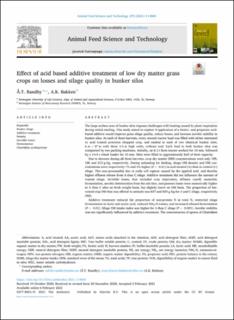| dc.description.abstract | The large surface area of bunker silos imposes challenges with heating caused by plant respiration during initial ensiling. This study aimed to explore if application of a formic- and propionic acid-based additive would improve grass silage quality, reduce losses, and increase aerobic stability in bunker silos. At each of three harvests, every second tractor load was filled with either untreated or acid treated precision chopped crop, and ensiled in each of two identical bunker silos, 6 m × 27 m with three 3.5 m high walls, without roof. Each load in both bunker silos was compacted by two packing machines. Initially, an 8.3 t farm tractor worked for 10 min. followed by a 14.5 t wheel loader for 10 min. Silos were filled to approximately half of their capacity. Due to showers during all three harvests, crop dry matter (DM) concentrations were only 195, 186 and 213 g/kg, respectively. During unloading for feeding, silage DM density and DM concentrations were respectively 7% and 5% higher (P < 0.01) in acid treated (A) than in control (C) silage. This was presumably due to early cell rupture caused by the applied acid, and thereby higher effluent release from A than C silage. Additive treatment did not influence the amount of wasted silage. Invisible losses, that included crop respiration, effluent runoff, anaerobic fermentation, aerobic deterioration from the silo face, and gaseous losses were numerically higher in A than C silos on fresh weight basis, but slightly lower on DM basis. The proportion of harvested crop DM that was offered to animals was 837 and 829 g/kg for A and C silage, respectively (NS). Additive treatment reduced the proportion of non-protein N in total N, restricted silage fermentation to lactic and acetic acid, reduced NH3-N-values, and increased ethanol fermentation (P < 0.01). Silage DM intake index was higher for A than C silage (P < 0.001). Aerobic stability was not significantly influenced by additive treatment. The concentration of spores of Clostridium tyrobutyricum in spot silage samples from bunker silo faces was low or moderate, and did not differ according to additive treatment. Silo shoulder and side samples contained, however, significantly higher spore concentrations than mid and top samples. | |
